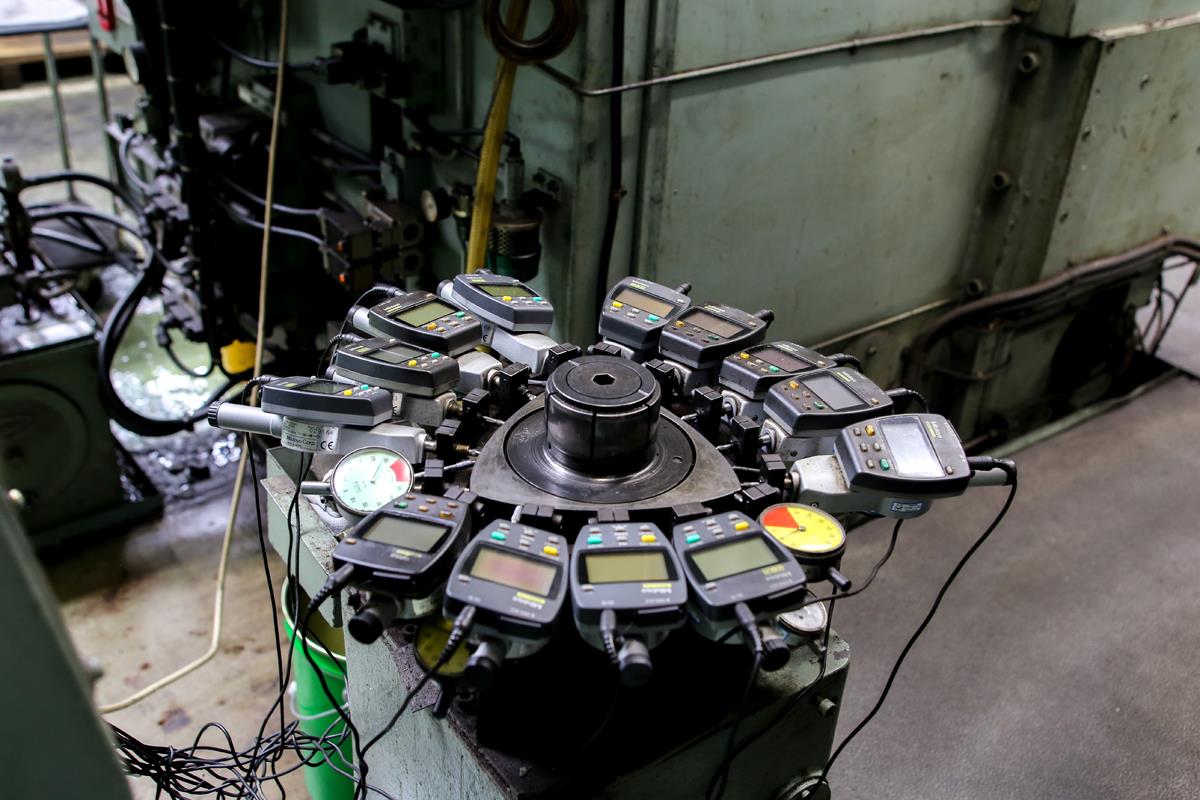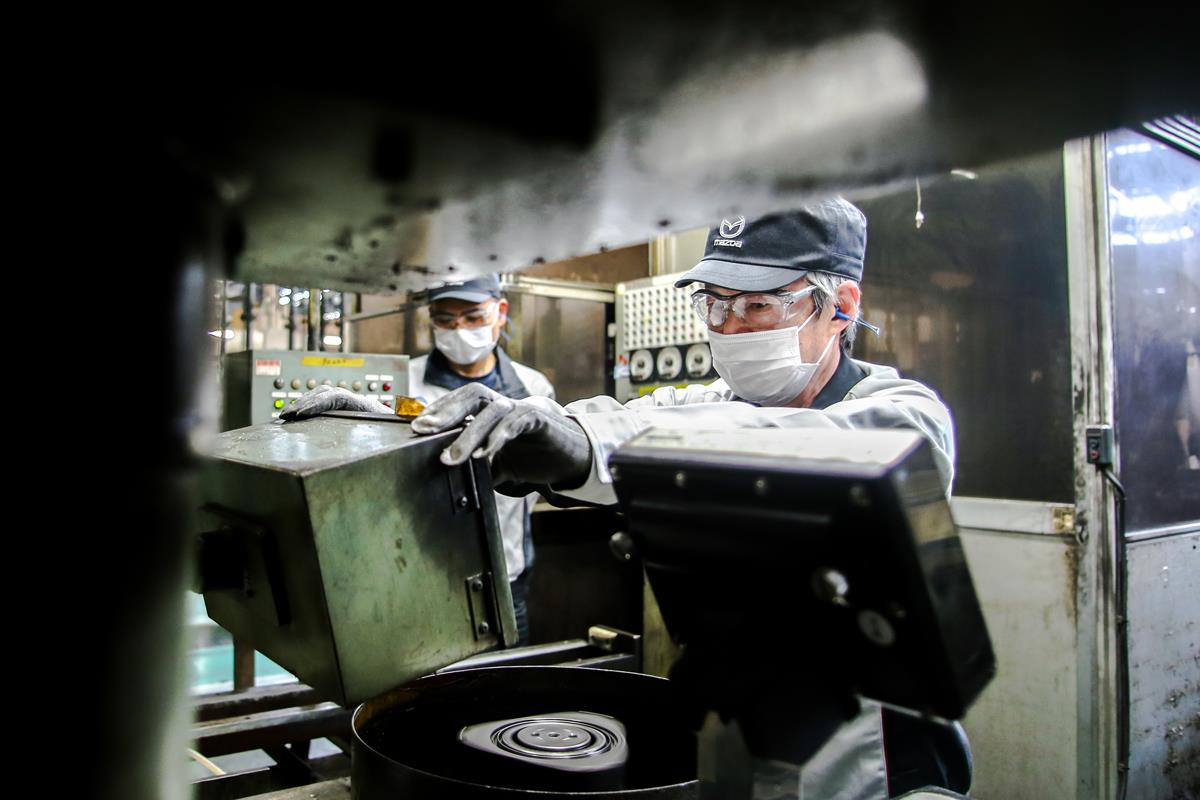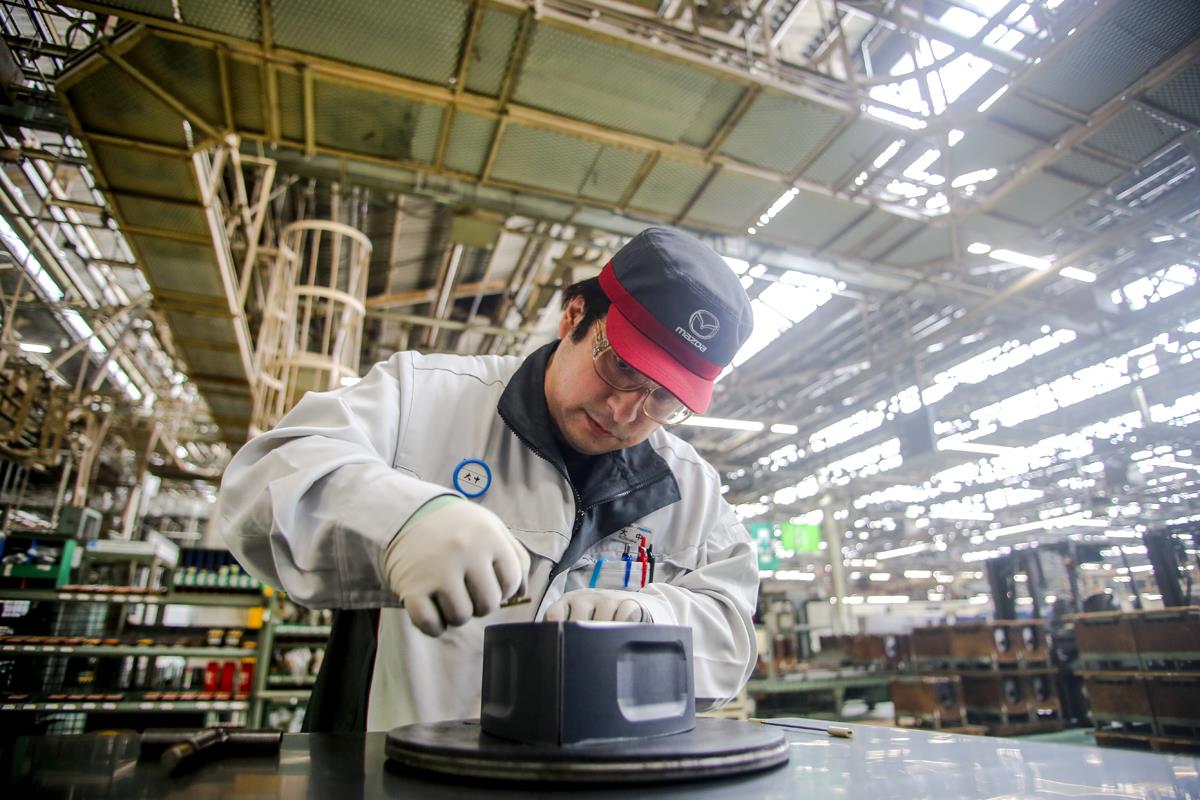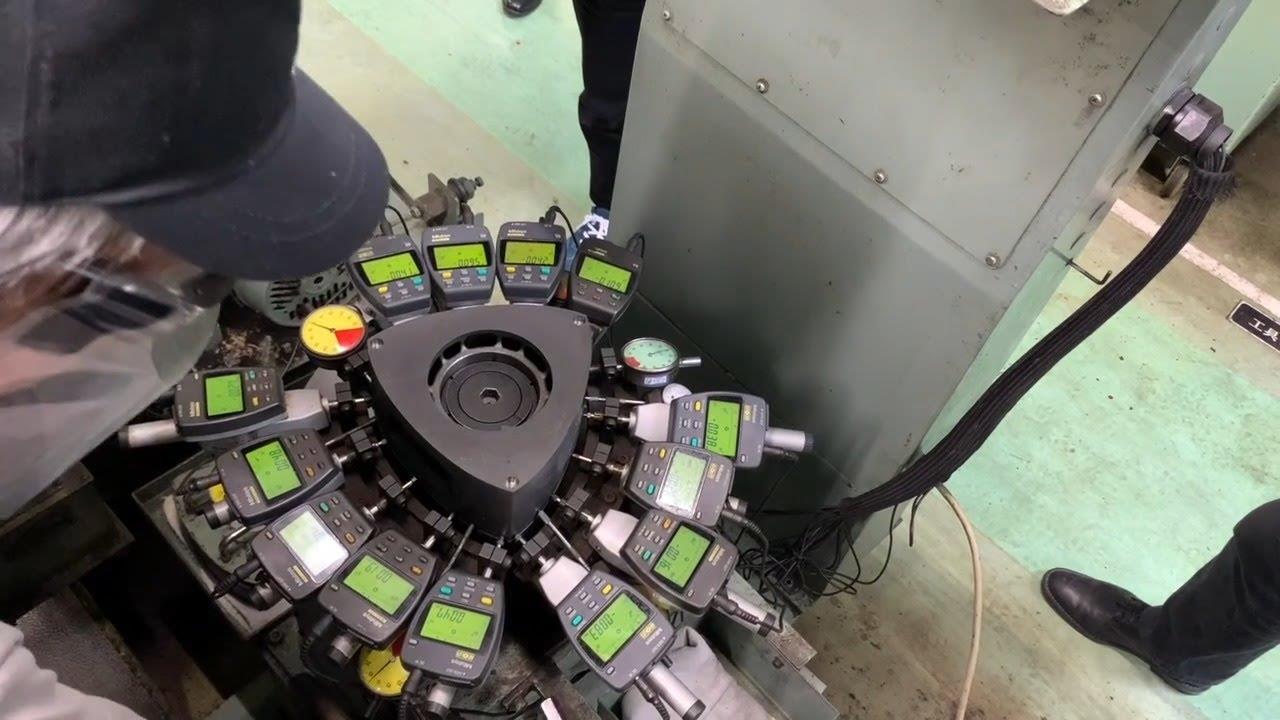
WE ARE MAZDA
The Intricate Process That Makes Each Rotary Engine a Work of Art
The craftsmanship, people, and passion behind the Mazda 13B rotary engine
Recap of the previous article:
In the last article, we embarked on a tour of a Mazda factory that has been producing 13B rotary engines since 1974. We delved into what exactly the rotary engine means to Mazda—and our reasons for not consigning it to the history books.
We took a glimpse into what could be called a grand baton relay—over half a century of rotary engine history being passed on to future generations. We met the Takumi—master craftsmen—involved in rotary engine production and got a sense of their passion for the “dream engine.”
Let’s continue our tour with our 36-year veteran rotary engineer, Tetsuya Sato, and take a deeper look into the inner workings of this fascinating factory.
To this day, each 13B rotary engine is still carefully hand-manufactured
We’ve already come a fair way into the factory, but there is still row upon row of towering machines ahead. Engineers work through each one of these processing machines before a single rotor—the heart of the rotary engine—is complete.
Scattered among the rows of machines, I can see tables stacked with measurement devices.
Sato explains, “We use these to inspect parts at critical stages in production to ensure optimal quality and precision. We inspect and perform maintenance on all the processing machines on a regular basis, and if it’s a particularly important machine, we’ll do this every time we need to use the machine. Even then, it’s still vital that we measure the parts after processing to be absolutely sure they’re finished to the highest standard possible.”
For some processes, this means a certain number of parts per lot are selected at random and inspected for precision. For other processes, the team inspects every part that goes through the machine. Of course, these inspections are all conducted manually.
I can see tables with neatly-arranged calipers, and others with numerous micrometers attached to measuring devices—the factory is equipped with every tool needed at every stage of processing to ensure every rotary engine is finished perfectly. Among all these instruments, one particularly peculiar device caught my eye.

“That’s an inspection jig used to make sure we’re achieving the exact design values for the outer periphery of the rotor. This is something we check on every rotor once it’s near completion, not just random samples. We’re meticulous. Even a slight deviation and we go back through the processing stages and make corrections until we’re fully satisfied,” explains Sato.
First, Sato attaches a perfectly-finished rotor, used as a master version to compare further rotors against, to the jig and resets the surrounding measurement devices to the correct settings. Next, he swaps the master rotor out for the rotor to be inspected and turns on the switch at the foot of the jig. The rotor quietly drops into the jig. He then checks and records each value shown on the measurement devices to determine if the rotor needs to be adjusted or if it can move on to the next processing stage. Every single rotor shipped from this factory goes through this inspection. And it’s all done by hand.
“These inspections are incredibly time-consuming, but they’re also processes that allow us to learn from those that went before us—that is, their understanding of what it takes to make rotary engines with the highest performance possible.”
“If you’re interested in this kind of work, I’ll show you something else.” Sato turns into a row of machines and leads me to a workspace surrounded by head-high processing machines.

“This is where we finish the rotor in terms of weight and dynamic balance. Dynamic balance refers to how the weight of the rotor is balanced, and it’s an extremely important factor in achieving smooth rotation. Of course, we do this for every rotor and, again, all by hand. Here, let me show you how.”
With that, Sato picks up a rotor awaiting the next step in processing, weighs it, and sets it in a machine. He then presses a switch, and the rotor starts to spin. A series of meters shows how balanced the rotor is before it stops spinning again. Next, he sets the rotor in another machine and files the parts that need adjusting while continuing to check the meter readings. He repeats this process of measuring and refining over and over until he sees the rotor has exactly the right weight and dynamic balance—and breaks into a smile.
“For people who think of modern, computer-controlled factories when they picture a factory, this kind of hands-on work may seem special. But it’s actually nothing special for us—it’s what we do every day here at Mazda. It’s not even that we switched to hand processing because rotary engines are no longer being installed in new cars and production volume dropped. This is how it always was. Every 13B rotary engine ever delivered to customers the world over was hand-manufactured in this exact manner, here in this factory.”
He pauses for a moment, then shares about himself.
“I loved cars as a high school student and made up my mind to work for an automaker. I joined Mazda because I was interested in the rotary engine. Back then, lots of new employees wanted to be involved in rotary engine production, so I consider myself very lucky that my dream came true. My friends from school were jealous when I told them I was working on the rotary engine. Being involved with the rotary engine was definitely the dream job for us engineers at Mazda back then, so, we were pretty proud of what we were doing. So, naturally, I was pretty upset when I heard we were no longer going to be using rotary engines in new cars. Yeah, I was pretty disappointed.”
“But at the same time, Mazda also decided to continue production of the rotary engine and its components. By continuing to produce rotary engines, which Mazda had entrusted with our dreams for the future of cars, we were showing our commitment to continue to support customers around the world who chose rotary engine cars.”
“Mazda has continued to produce 13B rotary engines have every single day since. And thanks to that, I’m still here, too.”
“I work here because I believe we have to reciprocate customer loyalty by continuing to produce high-quality rotary engine parts to ensure enthusiasts can continue to enjoy their rotary cars in tip-top condition. To do this, we need to maintain the equipment in this factory, which was born out of the creativity and craftsmanship of the original rotary engineers, understand the reasoning and meaning behind each part of the production process, and perform each process meticulously so we can keep the flame of the rotary engine burning for future generations.
All ten of the team members working at this factory feel the same way, and that’s what motivates them to do the hard, manual work of making 13B rotary engines. “They feel a sense of purpose and fulfilment in the daily work of producing rotary engines,” explains Sato on behalf of his colleagues, as he starts walking again.
“We do the final inspection of the finished rotors over here. Let me show you.”
A team of true Takumi—master craftsmen—with decades of experience in their craft guard Mazda’s vision for the rotary engine
Meet Norifumi Ohnaka, another engineer who’s been involved in 13B rotary engine production in this factory for the last 35 years. Like Sato, he can perform every process required to produce every component of a 13B rotary engine. I spoke to him just as he had finished the final inspection of a rotor that had completed the fabrication process.

“I’ve just finished performing an overall inspection to see if the width and depth of the apex and side seal grooves match specifications, if the gears that mount on the eccentric shafts are assembled correctly, and if there are any scratches or stains.”
He then begins turning the finished rotor in his hands as he inserts a special tool into a series of inspection points. Every now and again he rubs the area where the inspection tool is with his finger and holds it up to inspect it in the best light, looking at it carefully with a serious look on his face, over and over.

The inspection tool used to check side seal grooves
“We have a detailed, set procedure for maintaining inspection tool accuracy and reliably inspecting rotor condition. If we fail to follow procedure, we won’t just ruin the inspection tool—we’ll damage the rotors as well. When I rub each section with my fingers, I’m performing a tactile inspection to discern the margin of error. Checking by feel like this is just as important as inspecting the product visually.”
“Everything I know about rotary engines was passed on to me by engineers that came before me, and I believe we are responsible for passing this knowledge on to the younger generation at Mazda.”
Finished with this round of work, Ohnaka looks down at his hands for a moment, then laughs shyly. I could tell that as a true artisan, being in the limelight like this didn’t come naturally to him, and his mannerisms reminded me of Washio, who I’d met earlier. I realized I was looking at the real deal—what we call Takumi engineers here in Japan. The staff of this factory weren’t interested in being the center of attention and, instead, worked day in, day out, refining their skills to the highest level, all for someone else’s enjoyment.
“Thanks for the compliment but, for us, what we do is nothing special. We believe there are things you can’t go back to once you’ve stopped doing them, even just for a short time. Lost skills and forgotten machinery can’t be reclaimed. If we took a break from producing rotary engines, machines would rust, and we’d lose the engineers with the expertise to operate them. We’d also lose the tactile knowledge needed to perform tactile checks on each component that we learned by watching the hands of the original rotary engineers. More than anything, I have a feeling that we’d lose sight of the hopes, dreams, and vision these engineers had for the rotary engine. We believe we’ve been tasked with the job of keeping the rotary engine flame from going out and, for us, that’s enough to keep us going.”
“Let’s stop for some lunch soon,” someone suggested. Wow, how time flies! Looking up, I saw sunlight streaming in from the skylights in the factory roof, bathing the rows of machines in a white glow.
Up next: Passing Down the Legacy of Hand-Assembled Rotary Engines: Our Takumi Engineers





